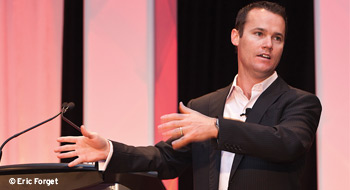
Even with the risks of disengagement, auto features are having a positive impact on the savings habits of employees in the U.S., said Michelle Simpson, vice-president of product management, Fidelity Personal and Workplace Investing. Fidelity research revealed that 70% of participants who are auto-enrolled into a DC plan do not opt out.
“Also, the default rate amount does not affect participation rate,” she added, meaning that members participated whether they were enrolled at a 3% or 5% contribution level. Furthermore, the vast majority of participants accepted or increased their auto-escalation rate.
The main point is that being enrolled at a certain rate may not be enough for employees to reach their goals. “To close the gap, employees need to increase the amount they save, adjust asset allocation and delay retirement,” said Simpson.
Global lessons in DC plans
Canada has a lot to learn from the U.K., Australia and the U.S., which have generally been running DC plans for longer, said Mazen Shakeel, a partner with Aon Hewitt. “The first key learning for Canada is to build flexibility into the plan design. Integrate TFSAs into retirement programs and permit withdrawals from RRSPs for homebuyer plans and lifelong learning plans.” This may stop younger employees from being reluctant to join because of other financial commitments.
“Next, consider mandatory participation and auto-enrollment to increase participation and savings rates,” he continued. To make it difficult for employees to opt out, Shakeel offered two tricks: force members to request an opt-out form (rather than including it with other materials), and “sweep” them back into the plan periodically.
Another way to boost enrollment is to provide incentives that encourage member savings. The most obvious way to do this is through a meaningful employer match. For plans that have automatic enrollment, when it comes to setting the default member savings rate, Shakeel agrees that it should be set quite high. “If you don’t set that default at the right level, there is a missed opportunity. Either set it high and don’t increase [it], or set it low and have a mechanism in place to auto-increase contributions regularly.”
Another lesson to take from other countries with strong DC plans is to monitor the right metrics. “Dig into participation levels to see who is participating and who is not,” he said. This will help to shape communication and engagement strategies going forward. “Also look at who is saving and at what rate. Ask yourself what you can do to encourage more savings.” Finally, don’t forget to review investment behaviours, he cautioned. Watch to see if participants know how to use TDFs, and ensure that they’re not making erratic decisions in reaction to market fluctuations.
The value of financial literacy
Engaging employees in financial decision-making is not about making them CFAs but about making it easier for them to make investment decisions.
Nigel Branker, a partner with Morneau Shepell, and Christine van Staden, regional vice-president, group savings and retirement, business development, Central Canada, with Standard Life, said the way to achieve this level of engagement is through personalized, customizable tools and information to motivate employees to care about their financial future.
Branker outlined a three-part equation to get employees to think about what savings they already have, what they need to achieve their retirement goals, and what else could happen that they need to prepare for (e.g., an unforeseen health issue). DC plan sponsors should develop an interactive website—or leverage what’s already offered by providers—that walks employees through these three areas. Each step should include as much personalized information as possible, such as age, account balance and expected retirement date for each employee.

“Members can’t make a decision when they don’t consider all of the information,” he pointed out. “So the goal is to help members bring all of that together.” Sponsors must make it easy for members to incorporate other savings data (such as government pensions and personal savings) into online retirement calculators, allowing them to easily provide an accurate and personalized suggested range for what a member should save to meet retirement goals.
To further customize communication, van Staden said sponsors need to segment their plan membership. Segments might be determined by demographics, life stages, contribution levels, investment selections or a combination of these elements. Each group will have different needs when planning for retirement.
On an individual level, van Staden said the magic formula for engaging employees is to consider their life stage, know their investment knowledge level and look at the amount they have already saved for retirement. “The focus for a younger employee will be to get him into a plan and starting saving,” while for an older employee, it will be to ensure that he or she is rebalancing the portfolio and beginning to envision retirement.
Both Branker and van Staden agreed that if plan sponsors can help members see where they are now, in terms of retirement planning—as well as where they need to be—it should motivate them to make appropriate investment decisions.
Leigh Doyle is a freelance writer based in Toronto. leigh.doyle@gmail.com
Download a PDF of this article and other coverage from the 2012 Benefits & Pension Summit.

 Investing in wellness critical to culture
Investing in wellness critical to culture Volatility, large liabilities challenge DB plans
Volatility, large liabilities challenge DB plans